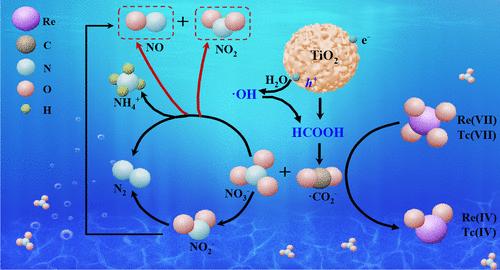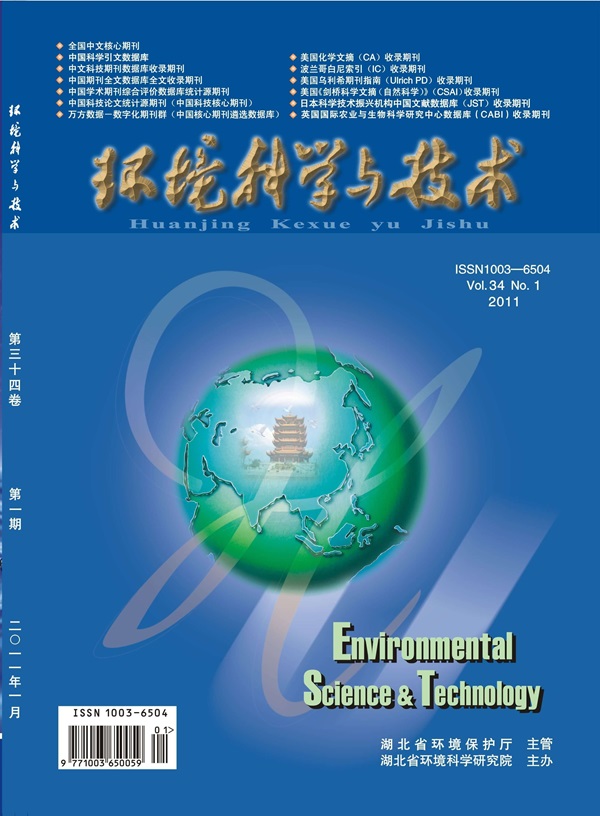Antagonistic Effect of Nitrate Conversion on Photocatalytic Reduction of Aqueous Pertechnetate and Perrhenate
IF 10.8
1区 环境科学与生态学
Q1 ENGINEERING, ENVIRONMENTAL
引用次数: 0
Abstract
Sustainable photocatalysis can effectively reduce the radioactive 99TcO4– to less soluble TcO2·nH2O(s), but the reduction efficiency is highly susceptible to coexisting nitrate (NO3–). Here, we quantitatively investigate photocatalytic remediation conditions for Tc-contaminated water stimulated by the analogue perrhenate (ReO4–) in the presence of NO3–, and we elucidate the influence mechanism of NO3– by in situ characterizations. The interfering NO3– can compete with Re(VII) for the carbonyl radical (·CO2–) produced by formic acid (HCOOH) oxidation to generate nitrogen-containing products such as NH4+, NO2–, and NOx, resulting in the decrease in the Re(VII) reduction ratio. Under the conditions of 4% (volume ratio) HCOOH and pH = 3, the yield of NOx is the lowest, and the selectivity of N2 reaches 93%, which makes the overall reaction more in line with the pollution-free concept. The X-ray absorption fine structure reveals that the redox product Re(IV) mainly exists in the form of ReO2·nH2O(s) and is accompanied by a decrease with the increase in NO3– concentration. Re(VII)/Tc(VII) reduction suffers from a serious interferential effect of NO3–, whereas the higher the concentration of NO3–, the more conducive to slowing down the reoxidation of the reduction products, which is advantageous for the subsequent sequestration or separation.

硝酸盐转化对水性过硫酸盐和过铼酸盐光催化还原的拮抗作用
可持续光催化能有效地将放射性 99TcO4- 还原为溶解度较低的 TcO2-nH2O(s),但其还原效率极易受到共存硝酸盐(NO3-)的影响。在此,我们定量研究了在 NO3- 存在的情况下,类似物高铼酸盐(ReO4-)刺激锝污染水的光催化修复条件,并通过原位表征阐明了 NO3- 的影响机制。干扰的 NO3- 可与 Re(VII)竞争甲酸(HCOOH)氧化产生的羰基自由基(-CO2-),生成 NH4+、NO2- 和 NOx 等含氮产物,导致 Re(VII)还原率下降。在 4%(体积比)HCOOH 和 pH = 3 的条件下,NOx 的产率最低,N2 的选择性达到 93%,使整个反应更符合无污染理念。X 射线吸收精细结构显示,氧化还原产物 Re(IV) 主要以 ReO2-nH2O(s) 的形式存在,并随着 NO3- 浓度的增加而减少。Re(VII)/Tc(VII)还原受到 NO3- 的严重干扰,而 NO3- 浓度越高,越有利于减缓还原产物的氧化还原,有利于后续的封存或分离。
本文章由计算机程序翻译,如有差异,请以英文原文为准。
求助全文
约1分钟内获得全文
求助全文
来源期刊

环境科学与技术
环境科学-工程:环境
CiteScore
17.50
自引率
9.60%
发文量
12359
审稿时长
2.8 months
期刊介绍:
Environmental Science & Technology (ES&T) is a co-sponsored academic and technical magazine by the Hubei Provincial Environmental Protection Bureau and the Hubei Provincial Academy of Environmental Sciences.
Environmental Science & Technology (ES&T) holds the status of Chinese core journals, scientific papers source journals of China, Chinese Science Citation Database source journals, and Chinese Academic Journal Comprehensive Evaluation Database source journals. This publication focuses on the academic field of environmental protection, featuring articles related to environmental protection and technical advancements.
 求助内容:
求助内容: 应助结果提醒方式:
应助结果提醒方式:


